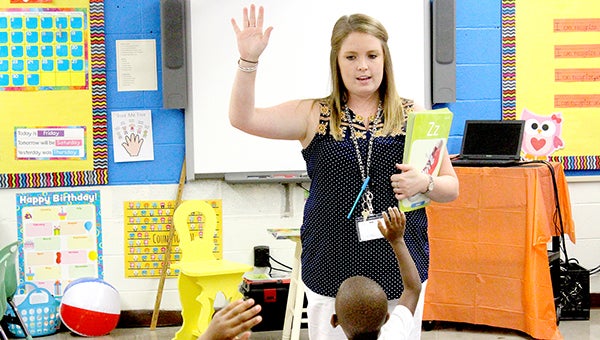As number of pre-K classes increases, so does performance
Published 10:42 am Monday, September 26, 2016

- Pre-K teacher Savannah Horton has her students raise their hands during class Friday.
Since 2014, the Vicksburg Warren School District has been working to expand on a service to benefit children and provide for a need in the community.
The district’s pre-K program has grown over the past three years from two classes to 13. Now there is at least one pre-K at every elementary school in the district except at Bowmar Elementary.
“There is national research that communicates very clearly that children who have access to quality pre-K struggle less,” VWSD Superintendent Chad Shealy said.
One reason Shealy wanted to expand the program is because student scores on tests, such as the MKAS Kindergarten Readiness Assessment, were low compared to the state average going into kindergarten, and he wanted more students to be able to access pre-K classes in an effort to better prepare students.
Data from the VWSD showed children who attended pre-K last year scored an average of 101 points higher on the MKAS Kindergarten Readiness Assessment than children who did not attend pre-K last year.
“We’re looking at a scale score difference in the students that attended our pre-K in the MKAS. They scored 101 scale score points higher at the beginning versus the ones who had not,” Shealy said. “So it is definitely a need for us to provide that for our students.”
He said research shows there is no achievement gap between children at birth but as babies grow, so does the gap. Shealy said children are better off when they can learn early language skills, literacy and numbers at a young age.
The system’s data also shows children enrolled in pre-K last year scored an average of 432 in testing at the beginning of the school year in August and improved their scores to an average of 564 at the end of the year on the May/April Post Assessment.
Another reason for expanding the program is because of the need in the community. When Shealy joined the district in 2013, he saw a district employee organizing rejection letters for people who applied to the pre-K program but were not accepted because there were only 40 spots available in the district.
Never wanting to tell any parent no, Shealy said he made it a priority to offer more pre-K classes because so many parents were trying to get the children into the program.
Each year since Shealy has been superintendent, he has added classes based on the amount of applications the district received. There were four classes in the 2014-2015 school year and eight in the 2015-2016 school year.
This year the district planned for 12 classes, but as applications continued to come in a 13th class was added in August.
While some federal funding is used toward the program, the district carries the bulk of the expense with approval by the school board.
Last year, approximately $400,000 was spent, and $1.2 million has been invested this year and for the future, according to data collected by district communications and media specialist Christi Kilroy and Marion Margaret Hern of the district curriculum department.
“The board has made a decision to pay for those,” Shealy said. “It’s worth it.”
As for future growth of the program, Shealy said he hopes the Mississippi Legislature will take heed and mandate pre-K statewide.
“My hopes are the Legislature will see it as something that is essential for our state, and if that decision is made to support pre-K, hopefully we can receive full funding for them like any other student,” Shealy said, adding until then every additional class added to the program is up to the school board.
So far he said he hasn’t had to reject any applications, and if a sufficient need is shown, he believes the system will try to find a way to support additional classes.
Pre-K applications can be found on the district’s website.





